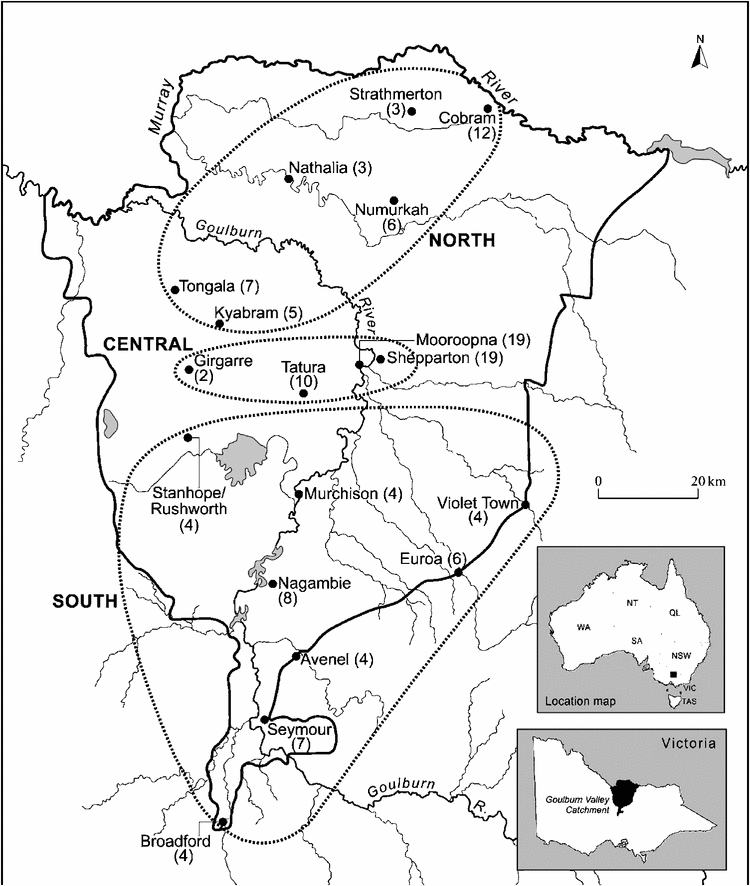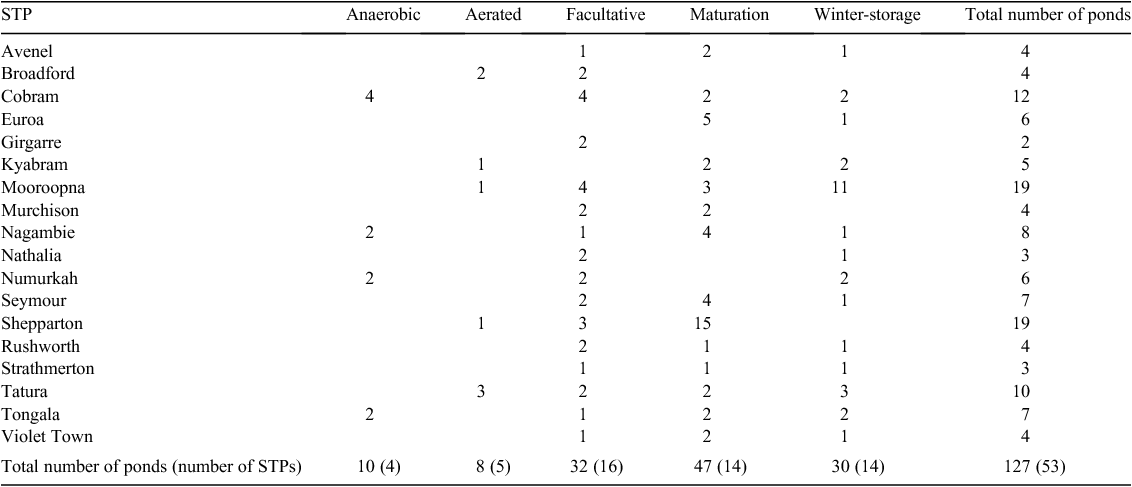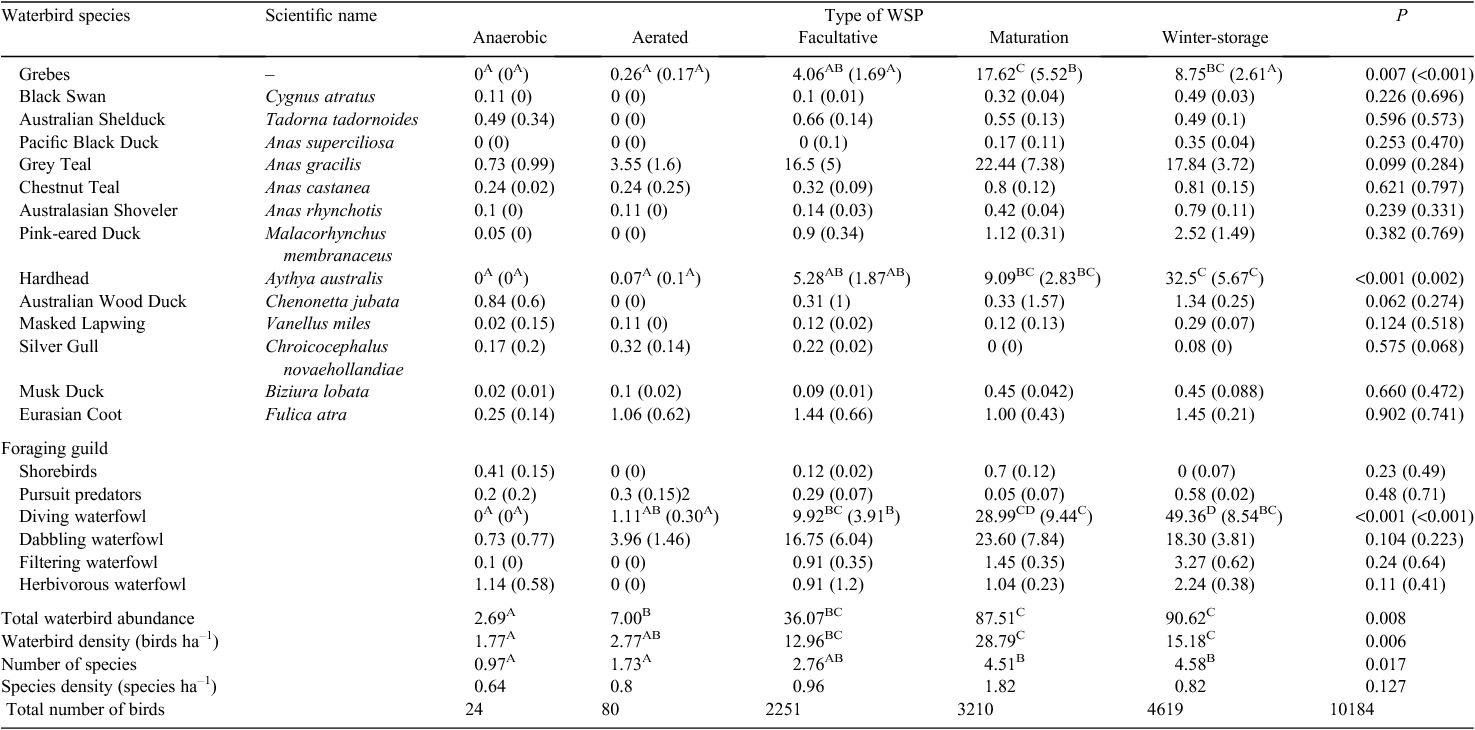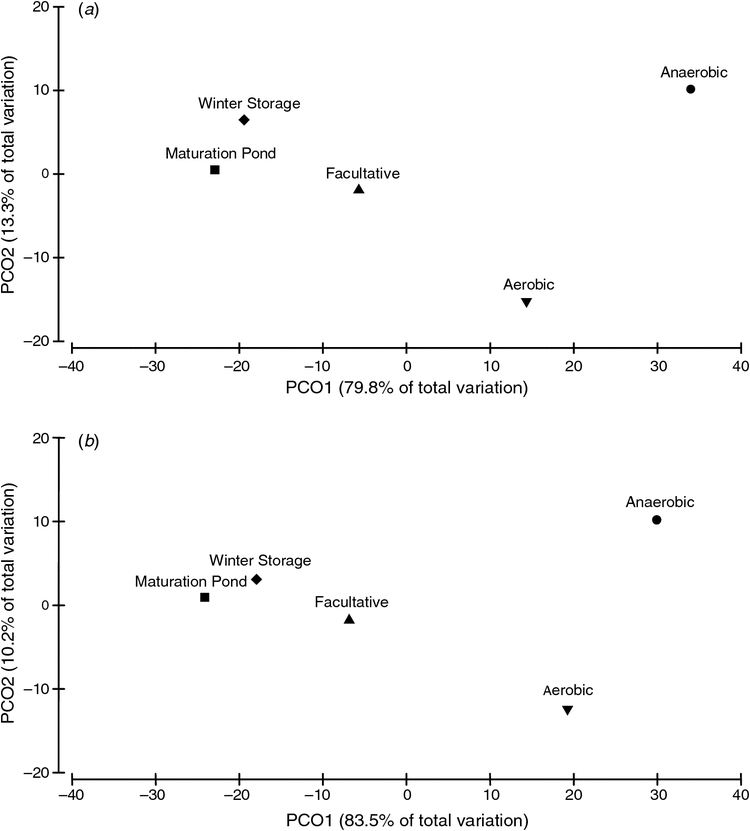Waterbird use of different treatment stages in waste-stabilisation pond systems
Christopher G. Murray A E , Sabine Kasel B , Erin Szantyr C , Regan Barratt C and Andrew J. Hamilton DA Department of Resource Management and Geography, Melbourne School of Land and Environment, The University of Melbourne, Parkville, Vic. 3010, Australia.
B Department of Forest and Ecosystem Science, Melbourne School of Land and Environment, The University of Melbourne, 500 Yarra Boulevard, Richmond, Vic. 3121, Australia.
C Goulburn Valley Water, Box 185, Shepparton, Vic. 3632, Australia.
D Department of Agriculture and Food Systems, Melbourne School of Land and Environment, The University of Melbourne, Dookie Campus, Dookie College, Vic. 3647, Australia.
E Corresponding author. Email: murray.chris.g@gmail.com
Emu 114(1) 30-40 https://doi.org/10.1071/MU12121
Submitted: 19 December 2012 Accepted: 11 June 2013 Published: 11 September 2013
Abstract
The significance of waste-stabilisation ponds (WSPs) to waterbirds has been well documented, but WSP differ depending on their place and purpose in the sewage-treatment system, and there is little information on how birds use these different types of pond. In mid-winter (July) 2012, waterbirds were counted on WSP at 18 sewage-treatment plants in the Goulburn Valley, Victoria. Winter-storage and maturation ponds supported greater abundance, density (birds ha–1) and richness of waterbirds than aerated and anaerobic ponds. There were no significance differences in the number of species per hectare among types of pond. The abundance and density of diving waterfowl on maturation and winter-storage ponds was greater than on anaerobic and aerated ponds. A multivariate analysis revealed that waterbird community composition (based on both abundance and density) differed significantly between maturation ponds and anaerobic ponds (P < 0.001) and also between winter-storage and anaerobic ponds (P < 0.01). Comparing among types of WSPs, the waterbird communities of anaerobic ponds were the most distinct and winter-storage and maturation ponds the least different. Although the primary objective of a treatment plant is to treat sewage there is some design flexibility and, where possible, increasing the size or number of maturation and winter-storage ponds, or both, would generally benefit waterfowl.
Additional keywords: biodiversity, conservation, ecology, sewage, wildlife management.
Introduction
The global importance of waste-stabilisation ponds (WSPs) for waterbirds has been well documented (Murray and Hamilton 2010 and references therein), including in Victoria, Australia (Hamilton and Taylor 2004; Hamilton et al. 2004; Steele et al. 2006), and in the United Kingdom (Fuller and Glue 1980, 1981), Africa (Blaker and Winterbottom 1968) and North America (Piest and Sowls 1985). The importance of artificial and recreated wetlands to waterbirds has increased as a result of the loss of natural wetlands. The use of such wetlands, including WSPs, by waterbirds is typically opportunistic, and little consideration has been given by managers of WSPs to the potential implications for either wastewater treatment or waterbird conservation. Further, there seems to have been little examination of how differences in avian species richness, abundance and density through the sewage treatment system might affect these objectives. This study seeks to redress this paucity of information.
In a recent study of the use of different types of wetlands by waterfowl over 22 years in south-eastern Australia, WSPs were found to support significantly greater species richness, abundance and density of many waterfowl species and also a different waterfowl community to other wetland types examined (deep marsh, open water, permanently saline and semi-permanent saline wetlands) (Murray et al. 2012). Although the Western Treatment Plant (WTP) at Werribee, west of Melbourne, is clearly the most well known sewage treatment plant (STP) to birdwatchers – a ‘Disneyland for birdwatchers’ (Dooley 2007) – we confirmed that the finding of the importance of WSPs in Victoria was not an artefact arising from this single STP (Murray et al. 2012).
Despite the importance of WSPs, only one published study (Hamilton et al. 2005) has investigated whether waterbirds exhibit a general preference for WSPs at a particular stage of waste-water treatment and that study was restricted to the WTP alone. Hamilton et al. (2005) found that the highest density and diversity of waterbirds, and of zooplankton, were usually found in the ponds towards the end of the treatment system, although no conclusions could be drawn regarding the importance of the oxygenation or limnological status of the ponds.
In a typical waste-treatment system, the first one or two ponds are classified as anaerobic because there is no free oxygen owing to the high organic loading (>250 kg biochemical oxygen demand (BOD) ha–1 day–1) within the ponds (Smith and Scott 2005). The first ponds are usually followed by facultative ponds, which have an anaerobic lower layer of water and an aerobic upper layer. The last ponds in the series, the maturation ponds, are oxygenated throughout their depth profile and are sometimes called aerobic or oxidation ponds. There are many variants on this basic typology, but the two noteworthy additions in Victoria are aerated ponds, which are ponds that would otherwise be anaerobic but are oxygenated artificially, and winter-storage ponds. The latter are common in STPs in the grazing country of the Goulburn Valley, Victoria, where treated effluent is used to irrigate pastures from late spring to early autumn. In winter, when irrigation demand is low or non-existent, winter-storage ponds are a useful means of avoiding discharge to inland waters, which typically requires further (and costly) treatment. Winter-storage ponds have the same oxygenation status as maturation ponds but are typically larger ponds.
A review of waste-water treatment wetlands found little scientific evidence to guide the construction of such wetlands, especially WSPs, with waterbird conservation in mind (Murray and Hamilton 2010). For waterbird conservation, it is important to know which ponds are preferred as habitat for waterbirds.
Conversely, it is recognised that waterbirds that inhabit waste-water treatment wetlands are potential sources of pathogens (Murray and Hamilton 2010). For example, Pour (2012), studying the risks of using treated waste water from the Shepparton STP for the irrigation of lettuce, found that in winter (June–August) the concentrations of Escherichia coli were low relative to summer (December–February), even though summer waste-water flows were larger owing to the increased activity of fruit canneries that did not contribute to the concentration of E. coli. It was expected that the concentrations of E. coli would be diluted in summer and Pour (2012) hypothesised that the large population of waterbirds on the WSPs in summer contributed to the increased concentrations of E. coli. For this reason, there may be instances where managers of STPs may need to discourage birds, and understanding which ponds they use most frequently would help direct such decisions. An alternative hypothesis to that proposed by Pour (2012), however, is that the concentrations of E. coli are temperature dependent and that lower concentrations of E. coli in winter are common with or without the presence of birds.
The aim of this study is to determine which WSPs in the sewage-treatment system are preferred by which species or foraging guilds of waterbirds. This knowledge should assist managers of STPs to manipulate the ponds or construct systems with the dual purposes of the efficient operation of STPs and the conservation of waterbirds. To this end, we surveyed 18 STPs in the southern Murray–Darling Basin to determine differences in abundance, density and species richness of waterbirds and waterbird community composition between the different types of WSPs.
Methods
Study area
The study area was the Goulburn Valley, a regional area of rural Victoria, 178 km north of Melbourne (Fig. 1) and within the Murray–Darling Basin, the food bowl of Australia (Burge 2011). The Murray–Darling Basin is a critical region for Australia’s waterbirds (Frith 1982) and an area where water resources have been under threat from the effects of agricultural irrigation (Kingsford 2000; Leslie 2001). We surveyed birds at 18 STPs throughout the Goulburn Valley in late July (mid-winter) 2012, a non-breeding period for waterbirds in south-eastern Australian.
The region was selected because the STPs within it are all managed by Goulburn Valley Water (GVW), whose management allowed us to visit their facilities. Access to the sites is restricted and admission is only possible with GVW staff in attendance. The security of the sites and limited human activity means that waterbirds present are rarely disturbed, providing a unique habitat for waterbirds.
In total, we surveyed 127 WSPs in the 18 STPs (Fig. 1, Table 1). Owing to low BOD or low flow-rate from the sewer, or both, the systems servicing many small towns omit anaerobic ponds and start treatment with a facultative WSP. Conversely, the three largest treatment plants (Shepparton, Mooroopna and Tatura), begin treatment with high-rate anaerobic lagoons (Wall et al. 2000). Such WSPs are covered and provide no habitat for waterbirds, and were thus excluded from the survey. The area and depth of each of the 127 WSPs were provided by Goulburn Valley Water (unpubl. data) are summarised for each of the five types of WSP in Table 2.
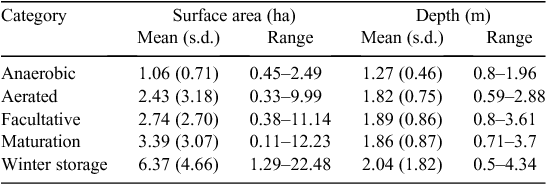
|
Waterbird surveys
The 18 STPs were grouped into three geographical strata (northern, central and southern; Fig. 1) to assist with sampling, so that each surveys of all the STPs within each stratum could be surveyed within 1 day. The three strata were surveyed in random order over 3 consecutive days, with each STP surveyed only once.
Waterbirds were counted at all WSPs at each STP surveyed. Waterbirds were identified to species, except for Australasian Grebes (Tachybaptus novaehollandiae) and Hoary-headed Grebes (Poliocephalus poliocephalus), which were combined (as ‘grebes’) because it was too difficult to identify them definitively owing to the large numbers present, often combined with large observation distances. The two grebes are combined in the diving foraging guild (Table 3) (Ropert-Coudert and Kato 2009). Surveys were conducted throughout the day, with all counts conducted either on foot or by car by the senior author, with the other authors tracking any movements of individuals or flocks and confirming identifications when required. Each WSP was surveyed only once at different times of the day. On each day, sampling started at c. 0900 hours (1.5 h after sunrise) and finished at c. 1700 hours (0.5 h before sunset). At each pond, we observed the entire shoreline and water surface with the aid of binoculars (Swarovski 8.5 × 40; Wattens, Austria). Birds on embankments between WSPs were considered to be on the pond closest to them. We have assumed that there was minimal diel variation in abundance (Hamilton 2004). We acknowledge that there may be diel movement of waterbirds between ponds (e.g. Mizutani et al. 1990) but consider our single observation at each pond a ‘snapshot’ in time that is adequate for the comparative purposes of this study.
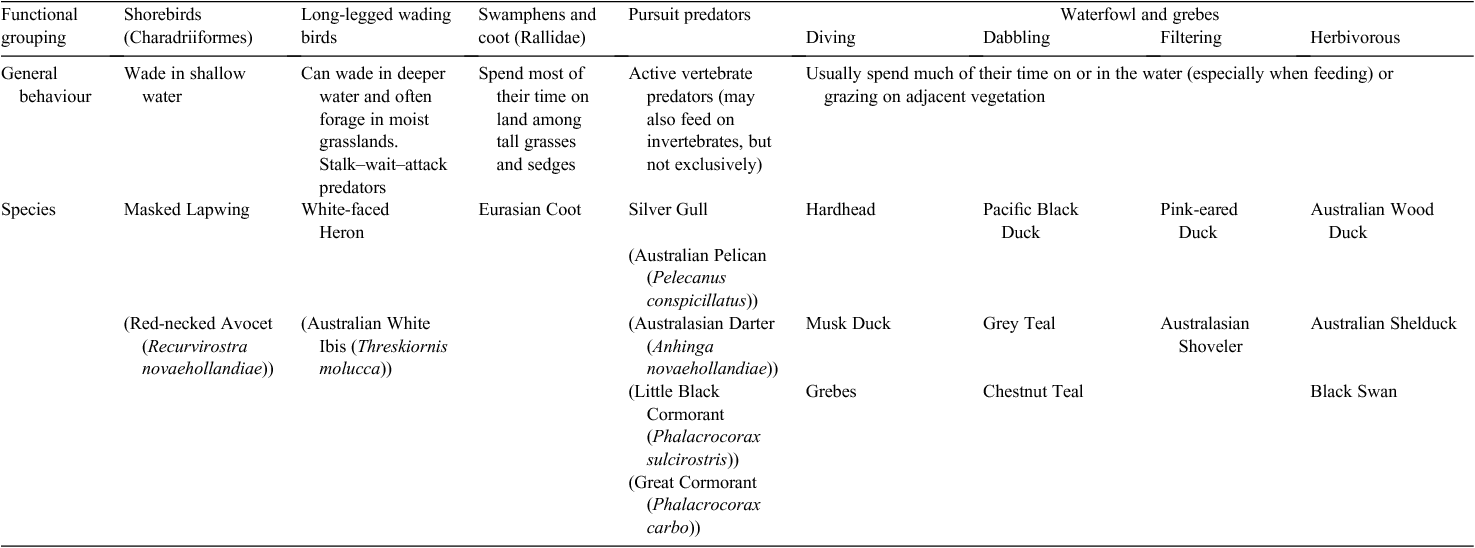
|
Analysis of data
Individual ponds of each type of WSP at each treatment plant are grouped together spatially. For this reason the statistical sampling unit for all analyses was WSP type within a specific treatment plant and not the individual ponds at a treatment plant. The individual ponds are effectively subsamples for each type of WSP at each STP. Thus, we had 53 sampling units across the five types of WSP (Table 1).
For both individual species and foraging guilds (Table 3), the effect of type of WSP on waterbird abundance and density (birds ha–1) was analysed using linear mixed models, which employed restricted maximum likelihood (Patterson and Thompson 1971). Mixed models provide a more general procedure than analysis of variance (ANOVA) and reduce to ANOVA in simple balanced cases. In this case, the design was unbalanced because the number of WSPs surveyed varied between type of WSP and across strata. The fixed effect (equivalent to a treatment in ANOVA) of WSP type was tested using a Wald statistic (Buse 1982), which is analogous to the F statistic used to assess treatment effects in ANOVA. For the random effects model, which equates to a blocking model in ANOVA, STP was nested within stratum. The response variables, abundance and density, were log10(x+1) transformed to improve normality and stabilise the variances; overall there was a significant effect of area on wetland type (Restricted Estimated Maximum Likelihood (REML), P < 0.001), so area was not included in the design as a covariant. Fisher’s least significance difference (l.s.d.) test (at P = 0.05) was used to make post hoc pairwise comparisons between means of fixed-effect levels (i.e. wetland types) for abundance and density analyses. All mixed model analyses were fitted using the statistical package Genstat V 11 (Lawes Agricultural Trust, Institute of Arable Crops Research (IACR)-Rothamsted).
The model was simplified in order to obtain convergence for several species in the abundance data. Block was removed from the abundance data for Grey Teal (Anas gracilis) and Pacific Black Duck (Anas superciliosa) and for the density data for grebes, Hardhead (Aythya australis) and the number of waterbirds per hectare. Negative variances were found, or convergence of the model did not occur, in those waterbird species or foraging guilds in which ≤10 birds were counted or where the waterbird was found on only one pond, and these species were eliminated from analyses of both abundance and density. Species excluded were Australian Pelican (Pelecanus conspicillatus; 14 birds, on only one pond), Australian White Ibis (Threskiornis molucca; 5 birds), Little Black Cormorant (Phalacrocorax sulcirostris; 4 birds), Australasian Darter (Anhinga novaehollandiae; 2 birds), Great Cormorant (Phalacrocorax carbo; 1 bird), Red-necked Avocet (Recurvirostra novaehollandiae; 1 bird) and White-faced Heron (Egretta novaehollandiae; 1 bird). The foraging guild of long-legged wading birds (6 individuals) was also eliminated.
Permutational multivariate analysis of variance (PERMANOVA) (Anderson 2001; Anderson et al. 2008) was used to test the effect of type of WSP on the composition of waterfowl communities, on the basis of abundance and density. The full model followed that used in the univariate analysis and included WSP type (fixed factor), stratum (random factor) and STP (random factor). Significance testing of the Bray–Curtis similarity measures (log10(x + 1) transformed) and post hoc comparisons (at P = 0.05) were made using 9999 permutations. Permuted residuals were calculated under a reduced model, and Type III sums of squares were used because the design was unbalanced (Anderson et al. 2008). Where differences were significant, a SIMPER test (Clarke 1993) was used to determine the waterbird species that contributed most to dissimilarity in the composition of waterbird communities among WSPs types. Principal coordinates ordination (PCO; Gower 1966) of distances between centroids was used to visualise the output of the PERMANOVA model (Anderson et al. 2008). All multivariate analyses were performed with PRIMER (V6.1.15) and PERMANOVA+ (V1.0.5) (PRIMER-E, Plymouth, UK).
Results
Abundance, density and species richness
Overall, across all 18 STPs, the mean abundance of waterbirds at each STP was 566 individuals and mean density at each STP 23.6 birds ha–1, with a overall mean species richness at each STP of 7.6 species and a species density of 0.8 species ha–1 (Table 4).
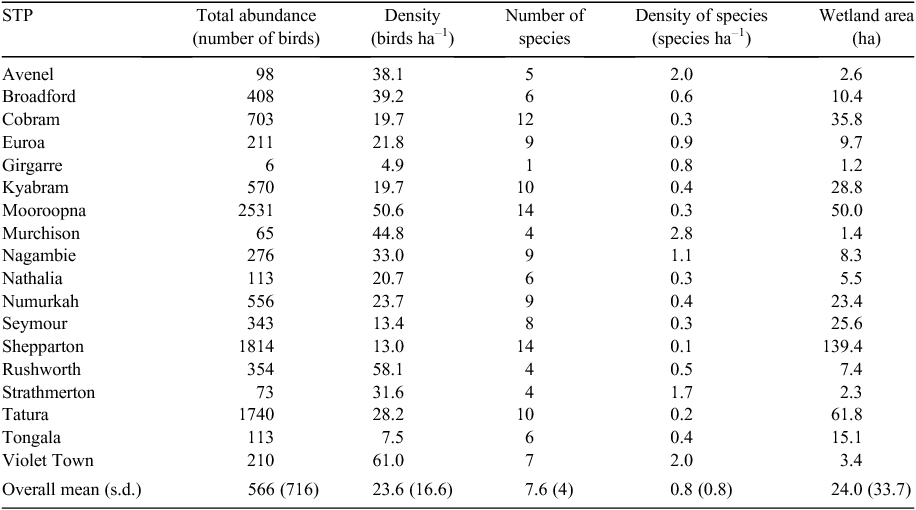
|
The total abundance, density and species richness of waterbirds varied significantly between types of WSP (Table 5). Waterbird abundance and species richness generally increased progressively through the treatment system, with values in winter-storage and maturation ponds significantly greater than in anaerobic and aerated ponds, and with similar trends for waterbird density (Table 5). Facultative ponds also supported a greater abundance and density of waterbirds than anaerobic ponds (Table 5). There were no significant differences in density of species (species ha–1) among WSP types (Table 5).
Significant differences in abundance and density of individual waterbird species and foraging guilds among types of types was limited to grebes, Hardhead and diving waterfowl (Table 5). With the exception of abundance in winter-storage ponds, maturation ponds supported a greater abundance and density of grebes than all other types of WSP (Table 5). Abundance and density of Hardhead in winter-storage and maturation ponds were significantly greater than in anaerobic and aerated ponds, with also significantly greater abundance and density in winter-storage ponds relative to facultative ponds (Table 5). The abundance and density of diving waterfowl on winter-storage ponds and maturation ponds was significantly greater than in anaerobic and aerated ponds (Table 5).
Community structure
PERMANOVA indicated that the composition of waterbird communities differed significantly among types of WSP, both in terms of waterbird abundance (P = 0.0134) and density (P = 0.0097). Pairwise comparisons revealed that the abundance and density of waterbird communities differed significantly between maturation ponds and anaerobic ponds (P < 0.001) and also between winter-storage and anaerobic ponds (P < 0.01). These differences were clearly evident in the distribution of samples across the first two axes of the PCO that respectively explained 93 and 94% of the total variance for waterbird abundance (Fig. 2a) and density (Fig. 2b). The PCO also demonstrated that the composition of waterbird communities within anaerobic ponds differed most from all other WSPs, and those of the winter storage and maturation ponds the most similar(Fig. 2a, b).
SIMPER analysis indicated that for both abundance and density data, Grey Teal, grebes and Hardhead made the greatest contributions to dissimilarity between maturation ponds and anaerobic ponds (combined dissimilarity 66–72%) and winter-storage and anaerobic ponds (58–63%).
Discussion
A recent analysis of the use of five different wetland types by waterfowl (Anatidae plus grebes (Podicipedidae) and the Eurasian Coot Fulica atra (Rallidae)) over a 22-year period across the state of Victoria found that WSPs supported greater numbers of individuals and greater density of species than all other types of wetland (deep marsh, open water, permanent saline, semi-permanent saline) (Murray et al. 2012). In this study of the Goulburn Valley STPs, waterbird abundance, density and species richness tended to be greatest in those ponds further through the treatment system, a finding consistent with the results of a previous study of a single STP, which found a positive correlation between the waterbird and invertebrate communities, with the greatest density and richness of invertebrates towards the end of the treatment system (Hamilton et al. 2005). Hamilton et al. (2005) suggested that this correlation implied that a diverse and abundant planktonic invertebrate community generally represents the type of pond ecosystem likely to support a high abundance and diversity of waterbirds. Hamilton et al. (2005) also found that the abundance of Hoary-headed Grebes tended to increase along a continuum of sewage-treatment stage. In this present study, we found that the abundance of grebes, Hardhead and diving waterfowl, tended to increase along a continuum of stage of treatment. These waterbirds also clearly preferred WSPs further through the treatment system where the preferred foods of Australasian Grebes (fish, snails and arthropods; Marchant and Higgins 1990) and Hoary-headed Grebes (predominantly invertebrates; Ropert-Coudert and Kato 2009) are more likely to occur. It should also be noted that because of the large number of ponds and treatment facilities surveyed in our study, we did not have time to quantify how the birds were using the ponds, but our informal observations of the birds seen on the anaerobic ponds suggested that they were using them as resting rather than feeding habitat, whereas much feeding was observed on all the other pond types.
In the earlier study of Murray et al. (2012), analysing a 22-year database derived from the Victorian Summer Waterfowl Count (for details, see Murray et al. 2012), WSPs supported a mean density of 22 birds ha–1 and species density of 0.5 species ha–1, compared with 3–5 birds ha–1and 0.06–0.10 species ha–1for other wetland types. In the present study, we found the 127 WSPs at 18 STPs supported a mean density of 23.6 birds ha–1 and a species density of 0.8 species ha–1, strikingly similar to the values obtained by Murray et al. (2012) from fewer STPs (n = 8) but over a much longer period (Murray et al. 2012). Interestingly, stormwater-treatment ponds surveyed in an urban environment (Murray et al. 2013) supported high densities similar to those of the WSPs (23.4 birds ha–1 and 3.8 species ha–1). Likewise, the densities on urban lakes (14.3 birds ha–1 and 3.0 species ha–1 (Murray et al. 2013) were also high and more similar to those on WSPs than the other, generally more natural, wetlands in the long-term study across Victoria (Murray et al. 2012). It is also of interest that for the Tatura STP, the total number of waterbirds counted (1740 birds) found on the single survey date in this study, approximates the waterfowl abundance for that site derived from the 22-year study (mean abundance 1101 ± s.d. 935), but of course this could merely be a coincidence. These findings confirm the consistency and importance of WSPs as non-breeding habitat for waterbirds.
There is a movement in Europe and elsewhere in the developed world towards the replacement of WSPs with activated sludge plants and other more intensive treatment systems, and it is unfortunate, from a conservation perspective, that government regulation may reduce the valuable waterbird habitat that WSPs constitute. In Europe, a law regulating urban waste-water treatment (COUNCIL DIRECTIVE of 21 May 1991 concerning urban waste water treatment (91/271/EEC) (OJ L 135, 30.5.1991, p. 40; see http://eur-lex.europa.eu/LexUriServ/LexUriServ.do?uri=CONSLEG:1991L0271:20081211:EN:PDF, accessed 2 August 2013) has been established ‘to protect the environment from the adverse effects of urban waste water discharges and discharges from certain industrial sectors (see Annex 3 of the Directive).’ This law prevents the use of open sewage fields for towns with a population exceeding 15 000 people after 2015 for new accession countries, and 15 years earlier, i.e. 2000, for other members of the European Community. However, the Urban Waste Water Treatment Directive does not explicitly prohibit the use of WSPs, because member states are required to ensure that waste-water treatment facilities are provided, particularly in sensitive areas such as freshwater bodies and coastal areas. In Australia there is no legal, or impending legal, impediment to WSPs but a disincentive to their use is that they require large areas of land and land is expensive. If the land was cheap and available this would be the preferred treatment method. However, within urban growth regions, demand for land is high and so STPs with a smaller footprint, such as activated sludge plants or other biological reactors, are preferred (Tsagarakis et al. 2003).
Within the Murray–Darling Basin, WSPs provide a permanent waterbird habitat that has been particularly important as a refuge in times of drought (Murray et al. 2012). However, after the Commonwealth Water Act 2007 was enacted, which created the Murray–Darling Basin Authority (http://www.mdba.gov.au/, accessed 2 August 2013), environmental flows have taken precedence over agricultural water requirements so that WSPs may become less critical for waterbirds. Conservation considerations must be part of any regulatory process, and water management practices at STPs that mitigate the effects of STP modernisation should be mandated to maintain the established role of WSPs for waterbirds. STP design engineers enjoy a measure of flexibility such that they can provide more maturation ponds, but environmental needs must be measured against the water demands for irrigated agriculture.
There are, however, management costs associated with releasing treated waste water to grazing paddocks or for the irrigation of crops. The gradual accumulation of salts in the soil, as well as degradation of soil structure related to sodicity, are of particular concern in many waste-water irrigation schemes (Hamilton et al. 2007), particularly on the heavy soils found in much of south-eastern Australia (Bond 1998; Muyen et al. 2011). Indeed, such problems have required management at STPs considered here, such as at Shepparton (Surapaneni and Olsson 2002). For this reason it may be more cost effective to retain some of the water in winter-storage ponds over summer so that they become in effect summer-storage ponds or ponds for conservation purposes. It is also expensive to treat waste water to a stage where it can be released into inland rivers (Pour 2012) and, if the economic argument can be made, it may be more cost effective to construct several conservation ponds and that will have benefits for the environment and consequently for waterbird conservation.
In the past, many of the STPs in the Goulburn Valley disposed of excess water through the use of evaporation basins, and anecdotal evidence from STP managers suggests that these basins were well used by waterbirds. With the environmental and regulatory push to increase water recycling (mostly pasture irrigation; Boland et al. 2006), such evaporation basins are no longer used at most STPs. However, at Murchison STP, the only plant surveyed where evaporation basins are still used, we observed several species that were not recorded at other STPs Brolga (Grus rubicundus; 2 birds), Purple Swamphen (Porphyrio porphyrio; 88) and Little Pied Cormorant (Phalacrocorax melanoleucos; 1). This supports the potential of evaporation basins for waterbird conservation, which is not surprising as the more gently sloping edges of evaporation ponds, compared with WSPs, would be more likely to be used by wading species. For example, White-faced Herons prefer to forage in open areas over soft to firm substrates and shallow water (Lowe 1983) and WSPs would be too deep for foraging whereas evaporation basins provide a more favourable foraging habitat (Powell 1987; White and Main 2005). Of course, salts would gradually concentrate in such evaporation ponds over time, which would lead to changes in pond ecology, to the advantage of some species but not others. This could be managed to a degree by periodic flushing or harvesting of salt.
Little waterbird breeding occurs on WSPs but evaporation basins might provide a useful substitute for the breeding habitat of ephemeral wetlands (Taylor 2008; Harrison et al. 2010). In Victoria, approximately one-third of the natural wetlands of the state have been lost through drainage since 1835 (Corrick and Norman 1980; Corrick 1981, 1982; State of the Environment Advisory Council 1996). Floods have also diminished as a result of water regulation and, as they are a requirement for breeding for the many species of Australian waterfowl that are known to breed on receding waters (Frith 1982), water regulation has also adversely affected waterbird populations (Briggs et al. 1994; Kingsford and Johnson 1998; Kingsford 2000; Leslie 2001). The ability to regulate water flows to evaporation basins to simulate floods may provide a significant benefit for breeding populations of some species of waterbirds and warrants further investigation.
Large congregations of waterbirds have the potential to affect the nutrient budgets of WSPs. However, whereas there is a wealth of literature demonstrating nutrient contribution of birds to lakes (Portnoy 1990; Manny et al. 1994; Marion et al. 1994; McKinnon and Mitchell 1994; Scherer et al. 1995; Post et al. 1998), no such studies have been conducted on WSP systems. WSPs are clearly different to lakes, not only in terms of typical nutrient concentrations and size, but with respect to the typically much higher densities of birds they support (Murray et al. 2012). The role of waterbirds in nutrient import and export warrants investigation, particularly because the potential exists for negative or positive effects on the sewage-treatment process. To date, the only study relating to municipal sewage treatment was of a constructed wetland, where birds were found to make a negligible contribution to levels of nitrogen and phosphorus, and certainly not enough to compromise the treatment objectives (Andersen et al. 2003).
Conclusions
Natural wetlands are being lost as a result of the increase in human population and, if waterbirds are to maintain their place in the ecosystem, alternative wetlands must be found. WSPs provide a viable alternative and this paper suggests possible pathways for optimising this valuable habitat resource. Providing environmental water to maximise the size of WSPs at the end of the treatment chain (maturation and winter-storage ponds), within the constraints of appropriate STP engineering, will provide further benefits for waterbirds, particularly for diving waterbirds. This paper provides a basis for the conservation argument for the use of environmental water for STPs.
Acknowledgements
We acknowledge the assistance of Stuart Harris of Goulburn Valley Water for providing access and transport to the 18 STPs. We thank three anonymous reviewers for comments that improved the manuscript.
References
Andersen, D. C., Sartoris, J. J., Thullen, J. S., and Reusch, P. G. (2003). The effects of bird use on nutrient removal in a constructed wastewater-treatment wetland. Wetlands 23, 423–435.| The effects of bird use on nutrient removal in a constructed wastewater-treatment wetland.Crossref | GoogleScholarGoogle Scholar |
Anderson, M. J. (2001). A new method for non parametric multivariate analysis of variance. Austral Ecology 26, 32–46.
Anderson, M. J., Gorley, R. N., and Clarke, K. R. (2008). ‘PERMANOVA+ for PRIMER. Guide to Software and Statistical Methods.’ (PRIMER-E Ltd: Plymouth, UK.)
Blaker, D., and Winterbottom, J. M. (1968). Bird counts at Strandfontein sewage works and Riet Vlei, Cape Town. Ostrich 39, 94–104.
| Bird counts at Strandfontein sewage works and Riet Vlei, Cape Town.Crossref | GoogleScholarGoogle Scholar |
Boland, A.-M., Hamilton, A. J., Stevens, D., and Ziehrl, A. (2006). Opportunities for reclaimed water use in Australian agriculture. In ‘Growing Crops with Reclaimed Wastewater’. (Ed. D. Stevens.) pp. 81–90. (CSIRO Publishing: Melbourne.)
Bond, W. J. (1998). Effluent irrigation—an environmental challenge for soil science. Australian Journal of Soil Research 36, 543–555.
| Effluent irrigation—an environmental challenge for soil science.Crossref | GoogleScholarGoogle Scholar |
Briggs, S. V., Hodgson, P. F., and Ewin, P. (1994). Changes in populations of waterbirds on a wetland following water storage. Wetlands (Australia) 13, 36–48.
Burge, L. (2011). Murray–Darling Basin Submission. Guide to the Proposed Basin Plan. Water Planning and the Environment. Available at: http://www.basinplan.com.au/media/user_documents/pdf/37871/burge-1297220072.pdf [Verified 2 August 2013].
Buse, A. (1982). The likelihood ratio, Wald, and Lagrange multiplier tests: an expository note. American Statistician 36, 153–157.
Clarke, K. R. (1993). Non-parametric multivariate analyses of changes in community structure. Australian Journal of Ecology 18, 117–143.
| Non-parametric multivariate analyses of changes in community structure.Crossref | GoogleScholarGoogle Scholar |
Corrick, A. H. (1981). Wetlands of Victoria. II. Wetlands and waterbirds of South Gippsland. Proceedings of the Royal Society of Victoria 92, 187–200.
Corrick, A. H. (1982). Wetlands of Victoria. III. Wetlands and waterbirds between Port Phillip Bay and Mount Emu Creek. Proceedings of the Royal Society of Victoria 94, 69–87.
Corrick, A. H., and Norman, F. I. (1980). Wetlands of Victoria. I. Wetlands and waterbirds of the Snowy River and Gippsland Lakes catchments. Proceedings of the Royal Society of Victoria 91, 1–15.
Dooley, S. (2007). ‘Anoraks to Zitting Cisticola: A Whole Lot of Stuff About Birdwatching.’ (Allen and Unwin: Sydney.)
Frith, H. J. (1982). ‘Waterfowl in Australia.’ 2nd edn. (Angus and Robertson: Sydney.)
Fuller, R. J., and Glue, D. E. (1980). Sewage works as bird habitat in Britain. Biological Conservation 17, 165–181.
| Sewage works as bird habitat in Britain.Crossref | GoogleScholarGoogle Scholar |
Fuller, R. J., and Glue, D. E. (1981). Impact on bird communities of the modernisation of sewage treatment works. Effluent and Water Treatment Journal 21, 27–31.
Gower, J. C. (1966). Some distance properties of latent root and vector methods used in multivariate analysis. Biometrika 53, 325–338.
Hamilton, A. J., and Taylor, I. R. (2004). Seasonal patterns in abundance of waterfowl (Anatidae) at a waste stabilization pond in Victoria. Corella 28, 61–67.
Hamilton, A. J., Taylor, I. R., and Rogers, P. (2004). Seasonal and diurnal patterns in abundance of waterbirds at a waste stabilization pond, Victoria. Corella 28, 43–54.
Hamilton, A. J., Robinson, W., Taylor, I. R., and Wilson, B. P. (2005). The ecology of sewage treatment gradients in relation to their use by waterbirds. Hydrobiologia 534, 91–108.
| The ecology of sewage treatment gradients in relation to their use by waterbirds.Crossref | GoogleScholarGoogle Scholar |
Hamilton, A. J., Stagnitti, F., Xiong, X., Kreidl, S. L., Benke, K. K., and Maher, P. (2007). Wastewater irrigation: the state of play. Vadose Zone Journal 6, 823–840.
| Wastewater irrigation: the state of play.Crossref | GoogleScholarGoogle Scholar |
Harrison, J. A., Williams, A. J., and MacIver, M. (2010). Breeding site selection by colonial waterbirds given various combinations of constructed or natural alternatives over a 10-year period. Ostrich 81, 197–203.
| Breeding site selection by colonial waterbirds given various combinations of constructed or natural alternatives over a 10-year period.Crossref | GoogleScholarGoogle Scholar |
Kingsford, R. T. (2000). Ecological impacts of dams, water diversions and river management on floodplain wetlands in Australia. Austral Ecology 25, 109–127.
| Ecological impacts of dams, water diversions and river management on floodplain wetlands in Australia.Crossref | GoogleScholarGoogle Scholar |
Kingsford, R. T., and Johnson, W. (1998). Impact of water diversions on colonially-nesting waterbirds in the Macquarie Marshes of arid Australia. Colonial Waterbirds 21, 159–170.
| Impact of water diversions on colonially-nesting waterbirds in the Macquarie Marshes of arid Australia.Crossref | GoogleScholarGoogle Scholar |
Leslie, D. J. (2001). Effect of river management on colonially-nesting waterbirds in the Barmah-Millewa forest, south-eastern Australia. Regulated Rivers: Research and Management 17, 21–36.
| Effect of river management on colonially-nesting waterbirds in the Barmah-Millewa forest, south-eastern Australia.Crossref | GoogleScholarGoogle Scholar |
Lowe, K. W. (1983). Feeding behaviour and diet of the White-faced Heron Ardea novaehollandiae in Westernport Bay, Victoria. Corella 7, 101–108.
Manny, B. A., Johnson, W. C., and Wetzel, R. G. (1994). Nutrient additions by waterfowl to lakes and reservoirs: predicting their effects on productivity and water quality. Hydrobiologia 279–280, 121–132.
| Nutrient additions by waterfowl to lakes and reservoirs: predicting their effects on productivity and water quality.Crossref | GoogleScholarGoogle Scholar |
Marchant, S., and Higgins, P. J. (Eds) (1990). ‘Handbook of Australian, New Zealand & Antarctic Birds. Vol. 1: Ratites to Ducks.’ (Oxford University Press: Melbourne.)
Marion, L., Clergeau, P., Brient, L., and Bertru, G. (1994). The importance of avian-contributed nitrogen (N) and phosphorus (P) to Lake Grand-Lieu, France. Hydrobiologia 279–280, 133–147.
| The importance of avian-contributed nitrogen (N) and phosphorus (P) to Lake Grand-Lieu, France.Crossref | GoogleScholarGoogle Scholar |
McKinnon, S. L., and Mitchell, S. F. (1994). Eutrophication and Black Swan (Cygnus atratus Latham) populations: tests of two simple relationships. Hydrobiologia 279–280, 163–170.
| Eutrophication and Black Swan (Cygnus atratus Latham) populations: tests of two simple relationships.Crossref | GoogleScholarGoogle Scholar |
Mizutani, H., Fukuda, M., Kabaya, Y., and Wada, E. (1990). Carbon isotope ratio of feathers reveals feeding behavior of cormorants. Auk 107, 400–403.
| Carbon isotope ratio of feathers reveals feeding behavior of cormorants.Crossref | GoogleScholarGoogle Scholar |
Murray, C. G., and Hamilton, A. J. (2010). Perspectives on wastewater treatment wetlands and waterbird conservation. Journal of Applied Ecology 47, 976–985.
| Perspectives on wastewater treatment wetlands and waterbird conservation.Crossref | GoogleScholarGoogle Scholar |
Murray, C. G., Loyn, R. H., Kasel, S., Hepworth, G., Stamation, K., and Hamilton, A. J. (2012). What can a 22-year database tell us about the use of different types of wetlands by waterfowl in south-eastern Australian summers? Emu 112, 209–217.
| What can a 22-year database tell us about the use of different types of wetlands by waterfowl in south-eastern Australian summers?Crossref | GoogleScholarGoogle Scholar |
Murray, C. G., Kasel, S., Loyn, R. H., Hepworth, G., and Hamilton, A. J. (2013). Waterbird use of artificial wetlands in an Australian urban landscape. Hydrobiologia , .
| Waterbird use of artificial wetlands in an Australian urban landscape.Crossref | GoogleScholarGoogle Scholar |
Muyen, Z., Moore, G., and Wrigley, R. (2011). Soil salinity and sodicity effects of wastewater irrigation in south east Australia. Agricultural Water Management 99, 33–41.
| Soil salinity and sodicity effects of wastewater irrigation in south east Australia.Crossref | GoogleScholarGoogle Scholar |
Patterson, H. D., and Thompson, R. (1971). Recovery of inter-block information when block sizes are unequal. Biometrika 58, 545–554.
| Recovery of inter-block information when block sizes are unequal.Crossref | GoogleScholarGoogle Scholar |
Piest, L. A., and Sowls, L. K. (1985). Breeding duck use of a sewage marsh in Arizona. Journal of Wildlife Management 49, 580–585.
| Breeding duck use of a sewage marsh in Arizona.Crossref | GoogleScholarGoogle Scholar |
Portnoy, J. W. (1990). Gull contributions of phosphorus and nitrogen to a Cape Cod kettle pond. Hydrobiologia 202, 61–69.
Post, D. M., Taylor, J. P., Kitchell, J. F., Olson, M. H., Schindler, D. E., and Herwig, B. R. (1998). The role of migratory waterfowl as nutrient vectors in a managed wetland. Conservation Biology 12, 910–920.
| The role of migratory waterfowl as nutrient vectors in a managed wetland.Crossref | GoogleScholarGoogle Scholar |
Pour, S. M. (2012). Norovirus disease risk in reuse of Shepparton Sewage Treatment Plant effluent for overhead irrigation of iceberg lettuce. Melbourne School of Land and Environment, University of Melbourne, Melbourne.
Powell, G. V. N. (1987). Habitat use by wading birds in a subtropical estuary: implications of hydrography. Auk 104, 740–749.
Ropert-Coudert, Y., and Kato, A. (2009). Diving activity of Hoary-headed (Poliocephalus poliocephalus) and Australasian Little (Tachybaptus nnovaehollandiae) Grebes. Waterbirds 32, 157–161.
| Diving activity of Hoary-headed (Poliocephalus poliocephalus) and Australasian Little (Tachybaptus nnovaehollandiae) Grebes.Crossref | GoogleScholarGoogle Scholar |
Scherer, N. M., Gibbons, H. L., Stoops, K. B., and Muller, M. (1995). Phosphorus loading of an urban lake by bird droppings. Lake and Reservoir Management 11, 317–327.
| Phosphorus loading of an urban lake by bird droppings.Crossref | GoogleScholarGoogle Scholar |
Smith, P. G., and Scott, J. G. (Eds) (2005). ‘Dictionary of Water and Waste Management.’ 2nd edn. (IWA Publishing and Elsevier: London.)
State of the Environment Advisory Council (1996). ‘Australia: State of the Environment 1996.’ (CSIRO Publishing: Melbourne.)
Steele, W. K., Hamilton, A. J., Taylor, I. R., and Loyn, R. H. (2006). Balancing wastewater treatment objectives and waterbird conservation objectives and waterbird conservation at a major sewage treatment plant. Proceedings of the 5th World Water Congress, 10–14 September 2006, Beijing, China. (International Water Association: London.)
Surapaneni, A., and Olsson, K. A. (2002). Sodification under conjunctive water use in the Shepparton Irrigation Region of northern Victoria: a review. Australian Journal of Experimental Agriculture 42, 249–263.
| Sodification under conjunctive water use in the Shepparton Irrigation Region of northern Victoria: a review.Crossref | GoogleScholarGoogle Scholar |
Taylor, I. R. (2008). Australia’s temporary wetlands: what determines their suitability as feeding and breeding sites for waders? Wader Study Group Bulletin 100, 54–58.
Tsagarakis, K. P., Mara, D. D., and Angelakis, A. N. (2003). Application of cost criteria for selection of municipal wastewater treatment systems. Water, Air, and Soil Pollution 142, 187–210.
| Application of cost criteria for selection of municipal wastewater treatment systems.Crossref | GoogleScholarGoogle Scholar | 1:CAS:528:DC%2BD3sXlt1Wqug%3D%3D&md5=1094bf0b1f0ef62a690f05f8c915a134CAS |
Wall, G., Hammond, B., Donlon, P., Johnson, N. D., Smith, J. C. (2000). Commissioning and operation of high rate anaerobic lagoon (HRAL) reactors. In ‘63rd Annual Water Industry Engineers and Operators Conference’, 6–7 September 2000, Warrnambool, Vic. Available at: http://www.wioa.org.au/conference_papers/2000/pdf/paper2.pdf [Verified 2 August 2013].
White, C. L., and Main, M. (2005). Waterbird use of created wetlands in golf-course landscapes. Wildlife Society Bulletin 33, 411–421.
| Waterbird use of created wetlands in golf-course landscapes.Crossref | GoogleScholarGoogle Scholar |


